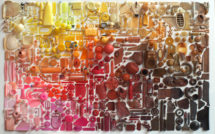

This is part of our special feature, Confronting Waste.
While food waste has long been considered in European media and regulations, until recently the issue of pre- and post-consumer textile waste had mobilized less public attention. In the European Union, although the exact figures put forth can vary, it is roughly estimated that out of the five million tons of textile entering the market every year, close to four million tons are discarded, whether used or unused. Moreover, clothing cast-off accounts for one of the fastest growing categories of waste in several countries in the Union. These astonishing numbers, a direct result of the emergence of the throw-away culture of “Fast Fashion” that leads to massive production of cheap clothes for insatiable and taste-changing consumers, have led the European Union to take up the issue of clothing waste in recent years. As an example, the EU-funded European Clothing Action Plan has sought to address clothing waste and promote sustainable fashion through a circular economy approach, explicitly linking with other European Commission projects, such as the EU Garment Initiative, and beyond Europe with the UN Sustainable Development Goals. Pointing to the shocking destruction of clothing when many people are in need, the issue of textile waste also highlights that, on the industrial side, surplus apparel production and disposal lead to intensified fossil fuel and water waste, increased pressure diverting agricultural land away from food production, toxic pollution, climate impact through carbon emissions, and an exacerbated problem of ever-growing landfills. While awareness is increasing, re-use filières are developing in collaboration with other sectors of the economy (such as the construction industry), and solutions are being proposed to consumers (for example through rental programs for fashionable outfits to be worn but a few times or eco-friendly companies advocating a buying-less-and-mending green mentality), the fashion industry still holds a solid grip on consumers, driving their purchasing behaviors and overall shaping their relationship with clothes.
Deborah Wynne highlights that, as pressing as the issue is in the twenty-first century, textile recycling was already a question of significant interest in nineteenth century England. I address the issue of clothing recycling with her from a historical and literary perspective. She shares her research on the complex role of rags in Victorian society, from a sought-after material necessary to support a growing paper industry serving the wealthier to a signifier of poverty and under-class in the city. She reflects on the ways in which literary writers of the time considered textile circulation and recycling to show its economic and social meaning. While industrializing and urbanizing Victorian England did not approach textile recycling along environmental principles, it nevertheless demonstrated a keen concern for circulating matter through cycles of use, re-use, and transformation, even creating a market along the way. While the Londoner ragged working child of Dickens’ novels and Baudelaire’s chiffonnier have long entered our imaginary as embodiments of utter poverty in the city, even if romanticized, couldn’t they also be conceived of as accidental and involuntary environmentalists of the past, who may inform the ways in which we shape the planet’s future?
—Hélène B. Ducros for EuropeNow
EuropeNow Could you tell us about your research on cloth in English literature and how you specifically came to examine issues of textile waste and textile recycling?
Deborah Wynne I have long been interested in the intersection between literary studies and material culture studies and this approach informs my research on representations of textiles in nineteenth-century literature. Fabric, clothing and textile activities, such as sewing, are depicted widely in Victorian culture, with writers often exploring cloth as the boundary that separates the individual body from the social body. My research engages with a broad range of cultural texts, including literature, autobiography, periodicals, illustration, screen adaptations and photography. In recent years, I’ve been particularly fascinated to discover that rags were used in Victorian Britain in the manufacture of paper. Textile recycling for the Victorians was a major industry and many of the urban poor made their living from collecting rags which were processed in paper mills before eventually being made into printed matter, such as newspapers and books. The personnel involved in recycling – beggars, orphaned children, and street collectors – featured in the fiction of the period, particularly in the work of Charles Dickens, who depicted so vividly the street life of London. Other writers depicted textile recycling, such as the social investigator Henry Mayhew, author of London Labour and the London Poor (1849-50), who was fascinated by the ubiquity of rags in London, which could be seen clothing the very poor or as detritus on the streets. He describes how rag-and-bone dealers offered incentives to thrifty working-class people to recycle worn cloth and suggests that the money made from collecting and selling rags was often used to pay for extra treats. He refers to a poster depicting a couple eating a large plum pudding, surmounted by the words, “From our rags!” (105-6). The ability of cloth to be transformed into different things, its potentially complicated life cycle, and the importance of cloth recycling for paper manufacture has been a major strand of my recent research.
EuropeNow What do you think the production, use and disposal of cloth can tell us about a society, whether past or present?
Deborah Wynne Fabric is common to all human societies and textile metaphors proliferate in numerous languages and cultures past and present. For example, phrases such as “spinning a yarn”, “following a thread”, “the social fabric” and “weaving a plot” are common to many languages. Indeed, the notion of society as a “fabric” was particularly prevalent in the discourses of nineteenth-century Britain. Thomas Carlyle in his book Sartor Resartus (1833-4) states that “Society is founded upon Cloth” (41), referring not only to clothing as a conspicuous outward sign of civilized social life but also to the overarching importance of the textile industries to British national prosperity. Cloth has historically been used as a currency, associated with dowries and repositories of wealth; it can also be made into an art form, as well as provide basic protection against the elements in the form of clothing. In historical terms, clothing was handed down from generation to generation when fashions changed very slowly, or garments were sold and resold repeatedly until they were too tattered to use. Rags were omnipresent in the lives of the very poor and many foreign visitors to Victorian Britain were shocked to see the number of ragged people on the streets of London and other major cities. Britain was at this period a wealthy industrial nation, and the sight of so many people in rags highlighted social inequalities and the lack of welfare mechanisms. Yet, paradoxically, rags were also a source of income for many poor people, a point Carlyle emphasizes in Sartor Resartus when he notes that rags picked from rubbish heaps move from gatherer to dealer, from dealer to manufacturer, “filling so many hungry mouths by the way” (35). The same is true today: the inadequacies of a society can be seen by the visibility of people living on the streets, poorly clothed, with inadequate bedding, yet as in Victorian society there is a monetary value in recycling textile waste and many people today are employed in this industry.
EuropeNow In your work on the representation of rags in nineteenth century British literature, what did you find about the role of rags economically, socially, and politically? Was the recycling of rags seen at all in terms of an explicit environmental benefit at the time?
Deborah Wynne In the 1850s there was an acute shortage of rags in Britain. There were taxes imposed on paper manufacturing which meant that British paper manufacturers paid a prohibitive levy on the rags they bought; however, overseas manufacturers could buy British rags without paying a penalty. This anomaly was subject to fierce debates in parliament and those who argued for the abolition of the tax pointed out that it made paper very expensive and that this meant that working-class people were unable to afford books and newspapers. Indeed, the tax became known as a “tax on knowledge” because poorer people could not easily access printed materials. There were many small-scale traders, dealers, collectors, and scavengers who exploited the fact that textiles were worth money, and even tiny scraps of old cloth or filthy rags were scavenged for the paper industry. In his novel Bleak House (1853) Dickens mentions a rag-and-bottle shop displaying in its window “a picture of a red paper mill, at which a cart was unloading a quantity of sacks of old rags” (63), a reference to a poster designed to encourage recycling. If the nation wanted newspapers, novels and notepaper, it needed people prepared to collect every scrap of discarded cloth.
By the 1870s, however, paper began to be manufactured from wood-pulp, bringing to an end the acute rags shortage and textile recycling then became less urgent. Unlike today, though, when the recycling of waste is presented as a way to save the environment from further exploitation, the Victorians recycled materials largely to make products more cheaply. Readily available waste was usually cheap, but the rags shortage of the 1850s was an anomaly; as the writer and political economist Harriet Martineau stated in 1854 in the magazine Household Words, rags had become “precious tatters” (243) now that paper was in short supply. She urged her readers to tell their servants “that rags now fetch a pretty penny; and let them have a rag-bag as a regular part of the kitchen establishment” (244). Servants traditionally were allowed to sell certain types of household waste for recycling and many supplemented their incomes by collecting rags for the paper industry at this period.
EuropeNow What is the relationship between the rag collector and industrialization?
Deborah Wynne The lowest level of textile trading was the work of the ragpicker. For Walter Benjamin, writing in his Arcades Project, the ragpicker, clothed in rags and working with rags, was a trader in the detritus of the city, the ultimate “figure of human misery” (349). The ragpicker was nevertheless key to the transformations effected by modern industrial processes. Baudelaire, writing in 1856, made this link when he said that the collector of rags is like “a miser guarding a treasure” which is needed by “the goddess of Industry” (quoted in Benjamin, 373). Rags thus became a marker of the underbelly of industrialization, necessary material for the recycling industry and the basis of all books and newspapers until the 1870s. Converting rags into paper was a complex industrialized process which was described by Charles Dickens and Mark Lemon in a collaborative article “A Paper-Mill” which appeared in Household Words in 1850. Based on a visit they made to a paper mill in Kent, the article celebrated the recycling process, describing how dirty, tattered, rejected cloth was transformed by mechanized processes into “white, pure, spick and span new paper” (529). Without the work of the ragpicker, however, who painstakingly collected rags from the streets, this industry would have ceased to function efficiently.
EuropeNow It seems that the rag collector is essentially an urban character. What is the rag collector’s relationship with the city? Were there rural rag collectors in the nineteenth century?
Deborah Wynne Paper mills devoted to converting textile waste into paper were usually situated in a rural locations beside rivers. But they could only function efficiently if a reliable source of rags came in from the cities. The ragpickers and collectors worked in urban areas, and then the textile waste they collected was transported to the paper mills in the countryside. Many rural places in England are still called “Papermill Bank” or “Papermill Lane”, a reminder of their former association with textile recycling. In Dickens’s novel Our Mutual Friend (1864), his heroine Lizzie is forced to escape London, moving to the countryside to work in a rural paper mill. This is presented as a virtuous trade, signaling her involvement in a socially useful recycling process. However, because rural areas didn’t have a significant amount of textile waste available, ragpicking was a trade which could only take place in highly populated urban areas.
EuropeNow You have written on ragged children in literature. Why do you think writers have been inspired by the image of the ragged child in Britain?
Deborah Wynne Both writers and artists, including photographers, were inspired in the nineteenth century by the concept of the child in rags. Destitute children, commonly seen on the streets, were widely considered to be legitimate objects of charity. National charities such as Dr. Barnardo’s, which was established in the 1860s to rescue orphaned and abandoned children, used photographs of ragged children to prompt people to make donations. Some of these children became involved in collecting waste for recycling, including ragpicking. The image of the child in poverty was inevitably signaled through representations of their tattered clothing, making the child in rags a cultural icon designed to stimulate humanitarian impulses. Victorian novelists, like artists and photographers employed by charities, also raised awareness of social issues relating to destitute children; however, it was Charles Dickens who particularly focused on the cultural and social meanings of rags in reference to vulnerable children. His characters, Oliver Twist, Florence Dombey, and David Copperfield, who Dickens represents in terms of pathos, experience a period in childhood when they lose their social identities and become victimized figures in ragged clothing. In the first chapter of Oliver Twist, for example, Dickens describes the new-born Oliver when he’s first wrapped in a blanket as classless, “he might have been the child of a nobleman or a beggar”; however, once he is dressed in the shabby workhouse uniform “he was badged and ticketed, and fell into his place at once – the orphan of a workhouse – the humble half-starved drudge – to be cuffed and buffeted through the world – despised by all, and pitied by none” (3). Dickens strongly resisted the idea that children should be judged by their garments, and Oliver Twist, David Copperfield, and Florence Dombey are all middle-class children who, by accidents of fate, end up abandoned and in rags, their shabby appearance usually leading to adults dismissing and degrading them. In his later novel, Bleak House, Dickens depicts Jo the Crossing Sweeper, a homeless orphan who is described as “a ragged figure” wearing “shapeless clothes hanging in shreds” (713). Dickens, who supported the Ragged School movement, whereby street children like Jo were given a basic education on a charitable basis, found the image of the child in rags a powerful way of raising awareness of the plight of destitute children in Britain. Rags, then, signified many things for the Victorians and had multiple associations, ranging from an expensive commodity bought by paper manufacturers to a way of earning a living for the rag-collector, as well as being a recognizable signifier of orphaned or abandoned children.
EuropeNow How might the function, role, or activities of textile recycling have changed in the twenty-first century?
Deborah Wynne Today textile recycling is encouraged for environmental reasons, largely because it reduces the need for landfill space. Some modern synthetic fibers do not decompose, which was not a problem that the Victorians had to face. Recycling today also means that fewer raw materials such as cotton, flax and wool have to be grown, freeing up pressure on the earth’s resources. Recycling textiles also means less use of polluting dyes. Textiles in wealthy countries, such as cast-off clothing, are often thrown out as waste when they are perfectly usable, and many are now sent to poorer parts of the world to be reused. Textiles are now commonly recycled into filling materials, such as car insulation, or as roofing felt, for example. The Victorians, however, although they did a lot of recycling of waste, were much less focused on environmental issues as the rationale for this, perhaps because populations were much smaller. Today, of course, there are many more pressures on resources and the recycling of waste becomes an urgent necessity.
Deborah Wynne is Professor of Nineteenth-Century Literature at the University of Chester, UK. She is the author of The Sensation Novel and the Victorian Family Magazine (2001) and Women and Personal Property in the Victorian Novel (2010), and has co-edited Charlotte Brontë: Legacies and Afterlives (2016). She has also published an article, “Reading Victorian Rags: Recycling, Redemption and Dickens’s Ragged Children”, in Journal of Victorian Culture (2015). Her latest co-edited book, Victorian Manufactured Objects, will be published by Routledge in 2019.
Hélène B. Ducros is Chair of Research and Pedagogy at EuropeNow. She earned a law degree (JD) and PhD in human geography from the University of North Carolina Chapel Hill. Her research on cultural landscapes and memory of place has interrogated the human-environment nexus and led her to examine issues of loss, decay, destruction, preservation, and re-claiming. At UNC-Wilmington, she created and designed the course on “Global Garbage, Trash, and Solid Waste.” Interested in the socio-cultural role of textile, she published “Reclaiming islandness through cloth circulation in Madagascar” in the Island Studies Journal (Nov. 2018).
References
Benjamin, Walter. 1999. The Arcades Project (ed.) Howard Eiland and K. McLaughlin, Cambridge, Mass.: The Belknap Press of Harvard University Press.
Carlyle, Thomas. 2008. Sartor Resartus (eds) Kerry McSweeney and Peter Sabor, Oxford: Oxford University Press.
Dickens, Charles and Mark Lemon, “A Paper-Mill”, Household Words vol.1 (31 August 1850): 529-31.
Dickens, Charles, Bleak House. [1853] 2003. (ed.) Nicola Bradbury (ed.), London: Penguin.
Dickens, Charles. [1837-8], 2009. Oliver Twist. K. Tillotson and S. Gill (eds.), Oxford: Oxford University Press.
Martineau, Harriet. 1854. “How to Get Paper”, Household Words, 10: 241-245.
Mayhew, Henry. 1861-62. London Labour and the London Poor,London: Griffin, Bohn and Company, vol.2.
Published on May 7, 2019.




